15 Types of Lavender to Grow at Home (with Pictures)
-
Ashley Bates
- Last updated:
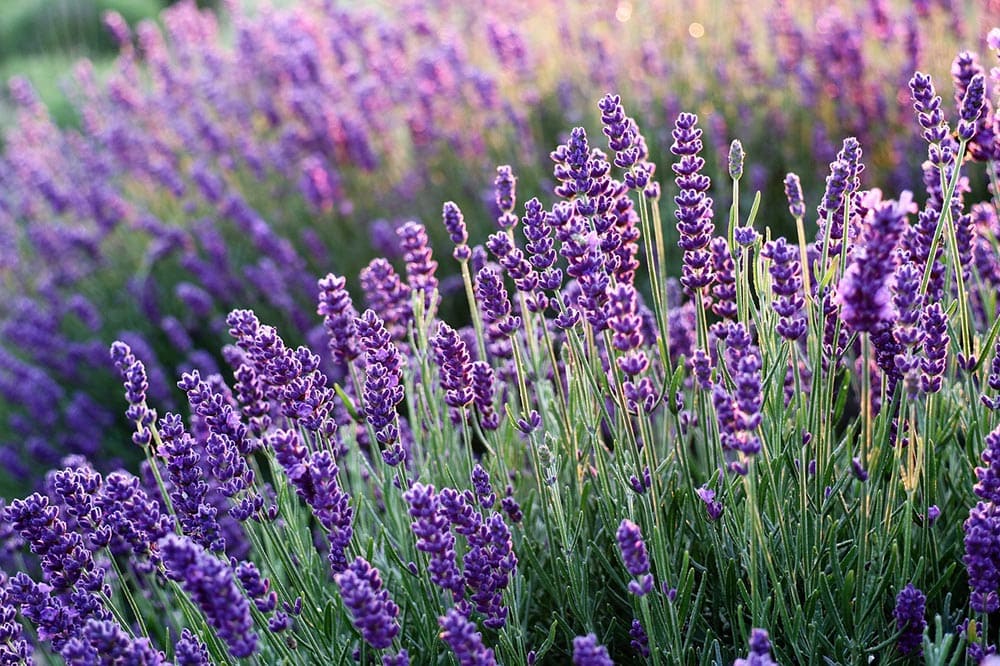
If you’re a gardener, you probably know all about lavender already. But do you know just how many variations of lavender there are? With hybridization and multiple original plant options, you have a broad selection you can choose from.
You can have one or many lavender varieties on your property, each coming with its own beauty and purpose. Even though lavender is traditionally purple, you might be surprised to know just how many color variations there are as well.
For your viewing pleasure, here are 15 of the most beautiful lavender plants you can grow in your garden.
The 15 Types of Lavender to Grow at Home
1. English Lavender

| Scientific Name: | Lavandula angustifolia |
| Sun: | Full sun |
| Bloom: | Midsummer |
| Mature Size: | 2-4 feet |
| Soil: | Sandy, well-drained |
| Hardiness Zone: | 5-8 |
English lavender is a beautiful woody, stalked, herbal perennial that looks beautiful in so many different landscape and garden settings. It is one of the most popular varieties of lavender that can be used medicinally or for pleasure.
Because they come back every year, you can expect the mature size to reach upwards of four feet in some cases. When this type of lavender flowers, the blooms are dark to light purple, but some can even be violent, blue, white, or pink if any hybridization is involved.
2. Spanish Lavender

| Scientific Name: | Lavandula stoechas |
| Sun: | Full |
| Bloom: | Spring/Summer |
| Mature Size: | 2-3 feet |
| Soil: | Sandy, well-draining |
| Hardiness Zone: | 8-9 |
You can visibly see the visual differences between English Lavender and Spanish Lavender. Spanish Lavender is an incredibly unique lavender variation to add to our list. Spanish Lavender has flowering heads that bloom instead of gorgeous violet blossoms.
In addition to these violet blooms, they can also be pink, purple, or white. What’s really unique about these lavender plants is that they are completely deer resistant, so you don’t have to worry about them munching your plants down to nubs.
3. Gayfeather Pink Lavender
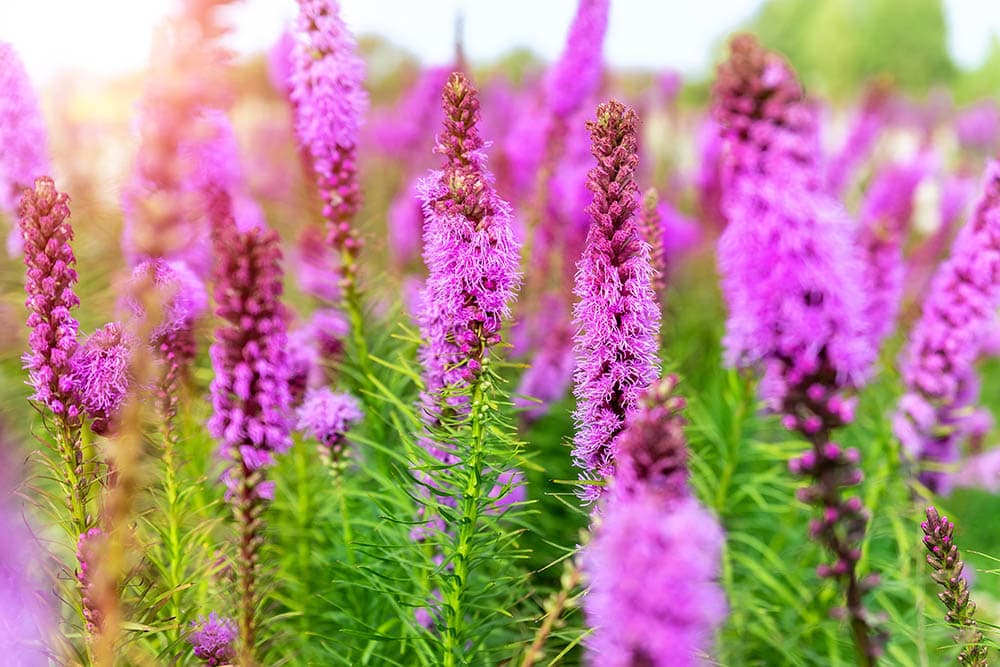
| Scientific Name: | Liatris |
| Sun: | Full |
| Bloom: | Spring/Summer |
| Mature Size: | 2 feet |
| Soil: | Sandy, well-draining |
| Hardiness Zone: | 3 |
Gayfeather pink Lavender is a beautiful addition to add to your landscaping. It has a unique bloom, making it highly attractive. This decorative type of lavender is often used for floral arrangements and other eye-catching pieces.
Also, this plant only reaches 2 feet at maturity on average (though it can get larger in some settings.) It tends to grow upward and high stocks rather than out, so it won’t smother the surrounding plants. This is a fantastic lavender to plant if you want to attract birds, bees, and butterflies.
4. French Lavender
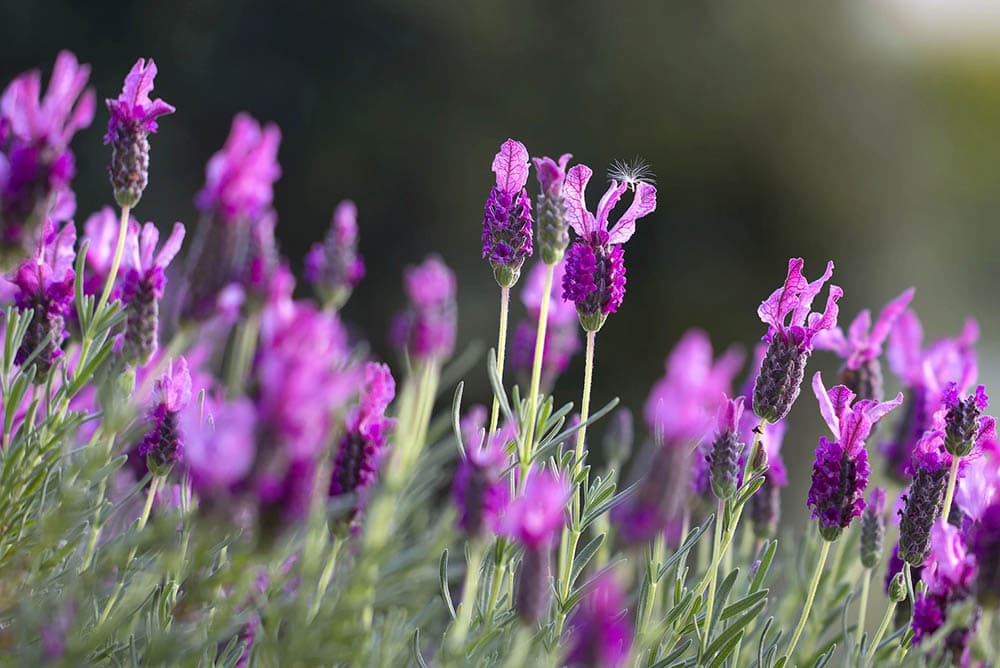
| Scientific Name: | Lavandula stoechas |
| Sun: | Full |
| Bloom: | Late Spring/ Early Summer |
| Mature Size: | 2-4 feet |
| Soil: | Sandy, well-draining |
| Hardiness Zone: | 8-11 |
French lavender is a traditionally royal lavender breed. Known for its beauty, it is often used for aromatherapy and for ornamental purposes. Gorgeous, large, and stunning, it’s the style you can see in lavender fields. This type of lavender is not used in cooking because it has poor flavor quality.
French Lavender has a beautifully serrated set of traditionally attractive blooms. The blooms are typically medium to dark purple and look beautiful and floral arrangements. Another exciting thing about French Lavender is that it blooms from spring to winter—so it’s very versatile!
5. Fernleaf Lavender
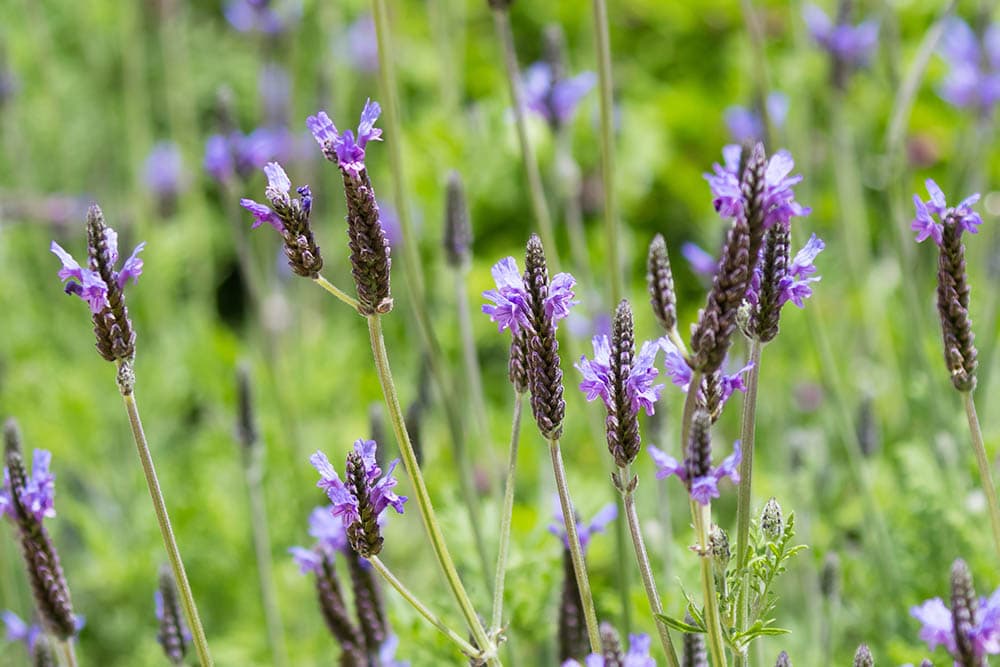
| Scientific Name: | Lavendulan multifida |
| Sun: | Full |
| Bloom: | Summer |
| Mature Size: | 1-2 feet |
| Soil: | Sandy, well-draining |
| Hardiness Zone: | 8-10 |
Fernleaf lavender is also known as French lace lavender. It gets its name from its fern-like leaves that have a Lacy feel. The main use for this type of lavender, aside from its aesthetics, is cooking, hygiene or care products, potpourri, and other scented products.
Growing firmly in warm climates that do not have winters will continue to produce beautiful flowers year-round. This Mediterranean variation can tolerate more moisture than other lavender plants.
6. Hidcote Pink Lavender
| Scientific Name: | Lavandula angustifolia |
| Sun: | Full sun |
| Bloom: | Spring |
| Mature Size: | 2-4 feet |
| Soil: | Well-draining |
| Hardiness Zone: | 5-9 |
The Hidcote pink lavender variety is an extraordinary addition to our list. Even though it has an unusual oil scent, it is still used for this purpose. It’s not the best-dried flower because it has a dry, brown color.
However, when it is in full bloom, the shade of this lavender plant takes on a pink hue, making it contrast beautifully alongside deeper lavender varieties. It’s grown mostly for aesthetics, providing beautiful appeal and charm.
7. Blue Cushion Lavender

| Scientific Name: | Lavandula angustifolia Schola |
| Sun: | Full |
| Bloom: | Summer |
| Mature Size: | 1-2 feet |
| Soil: | Chalky, well-draining |
| Hardiness Zone: | 5-9 |
Blue cushion lavender likely gets its name from its pin cushion look. These lavender plants make excellent landscape additions as they can be kept at a moderate size without snuffing out surrounding plants.
This particular lavender plant tends to bloom throughout the season. The blooms for this plant usually start very vibrant and deep, softening to a lighter color as the blooms age. This lavender is an excellent food source for birds and other forms of wildlife since it is nectar and pollen rich.
8. Grappenhall Lavender

| Scientific Name: | Lavendula Grappenhall |
| Sun: | Full |
| Bloom: | Summer |
| Mature Size: | 3-5 feet |
| Soil: | Sandy, well-draining |
| Hardiness Zone: | 5-8 |
Grappenhall lavender is widely used for its divine sense and unique blue-purple blooms. However this specific type of lavender cannot tolerate damp or standing water. It is also quite cold hardy, being able to handle harsh winters.
This is one of the largest lavender plants, growing upward of five feet tall. Because of its strong scent, it is beneficial for insect repellent and aromatherapy. In fact, it’s one of the most widely used lavender species for essential oils.
9. Imperial Gem Lavender

| Scientific Name: | Lavandula Imperial Gem |
| Sun: | Full |
| Bloom: | Late spring-Fall |
| Mature Size: | 1-2 feet |
| Soil: | Sandy, well-draining |
| Hardiness Zone: | 5-9 |
Imperial gem lavender is most commonly used for its looks. The appearance of this particular lavender species makes beautiful bouquets, dried arrangements, and other displays.
Imperial gem lavender is a brilliant selection for flower beds because it adds character to your landscape without getting too big. At maturity, these plans typically do not exceed 24 inches. These lavender plants are long bloomers, so you can enjoy them longer in warm months.
10. Woolly Lavender
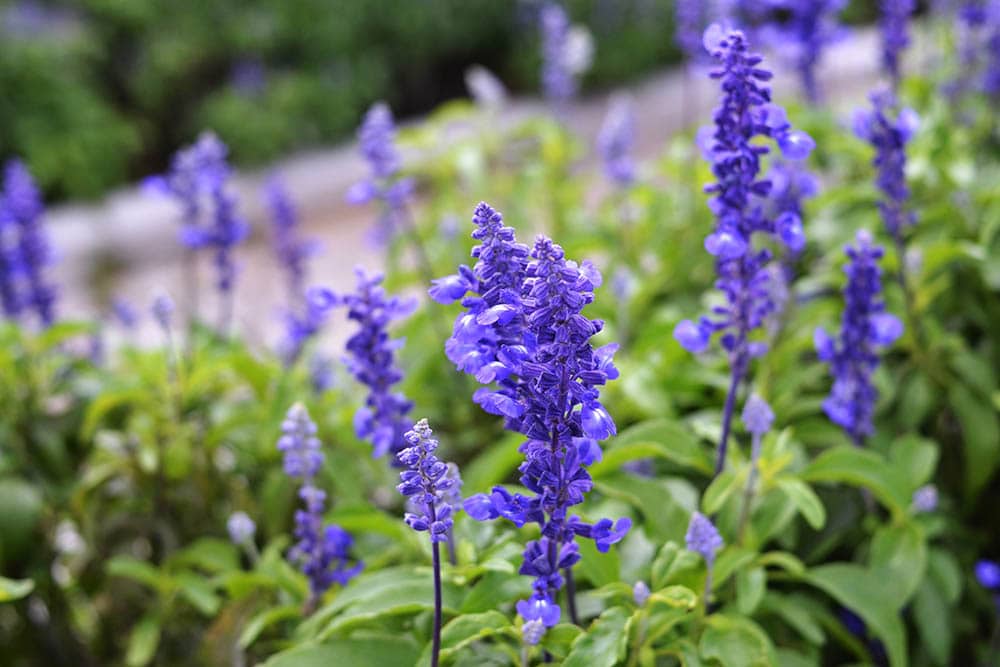
| Scientific Name: | Lavandula lanata Bioss |
| Sun: | Full |
| Bloom: | Spring-Summer |
| Mature Size: | 2-3 ½ feet |
| Soil: | Sandy, well-draining |
| Hardiness Zone: | 5-9 |
Woolly Lavender is native to Spain, and it has a lovely silvery hue. The stocks have a very fuzzy texture, hence the name. This particular lavender variety is incredibly drought tolerant, growing, and desolate conditions.
This unique plant looks great on display once it fully blooms. Also, if you want to attract pollinators to your garden, the bees and butterflies absolutely love this variety.
11. Grosso Lavender
| Scientific Name: | Lavandula intermedia Grosso |
| Sun: | Full |
| Bloom: | Summer |
| Mature Size: | 2-3 feet |
| Soil: | Well-draining, sandy |
| Hardiness Zone: | 6-10 |
Grosso lavender is one of the variations from France. It is known as the most fragrant of all lavender plants. It’s also equally beautiful, and you can enjoy these fragrant blooms for over four weeks in the summertime. The blooms are small and clustered, turning the classic lavender color.
This lavender plant does all of the right things. It is deer and rabbit-resistant, but it attracts pollinators to your gardens like bees and butterflies. You can harvest and hang dry at the end of the season to create beautiful arrangements.
12. Portuguese Lavender

| Scientific Name: | Lavandula latifolia |
| Sun: | Full |
| Bloom: | Summer |
| Mature Size: | 2-4 feet |
| Soil: | Sandy, well-draining |
| Hardiness Zone: | 6-8 |
Portuguese Lavender is also known as broad-leaved lavender. It has a classic spiky look with interesting, stacked blooms. This lavender is native to the Mediterranean region and is mainly used for perfume, aromatherapy, soap sockets, and other toiletries.
Because of their unique appearance, these flowers work excellent and floral arrangements and can add pizzazz to any landscaping. This lavender species attracts moths, butterflies, and bees. They are slow to seed, but the wait is worth the beauty.
13. Munstead English Lavender
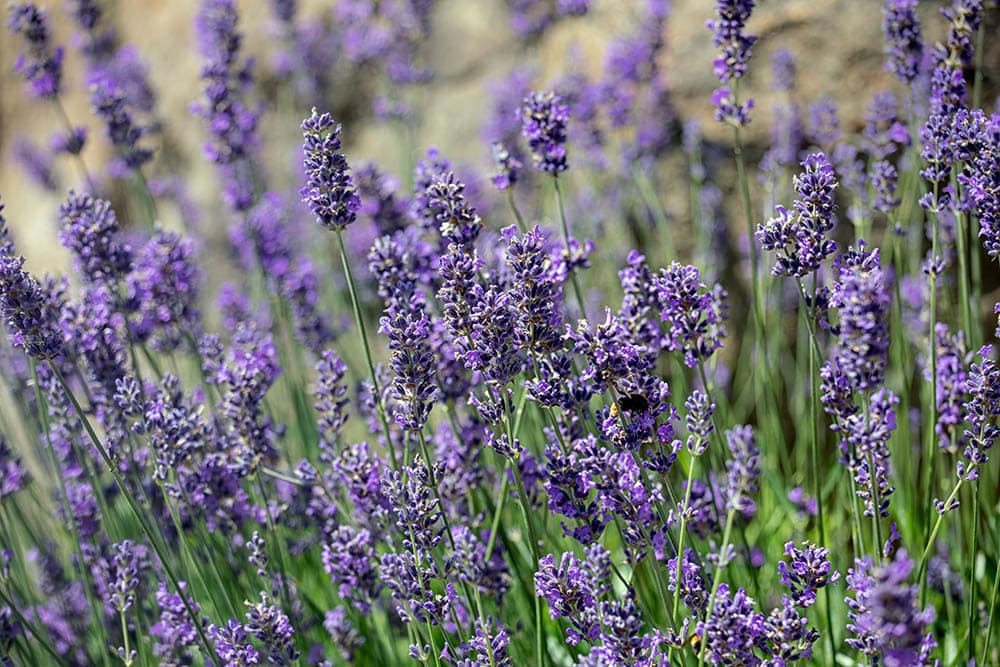
| Scientific Name: | Lavandula Angustifolia Munstead |
| Sun: | Full |
| Bloom: | Mid to late summer |
| Mature Size: | 2-3 feet |
| Soil: | Dry, well-draining |
| Hardiness Zone: | 5-9 |
The Munstead English lavender variety blooms beautifully. It has cool lavender-blue spikes with charming grayish-green foliage. The small blooms or slightly spaced sprawling flowers if you get close enough to look.
They are very low maintenance and are typically used for container growing, floral cuts, or mass planting. This style of lavender looks beautiful on fence lines and walkways, and it makes terrific essential oils and hygiene supplies. You can enjoy these blooms a little later in the year, from mid to late summer.
14. Lavenite Petite Lavender

| Scientific Name: | Lavandula angustifolia |
| Sun: | Full |
| Bloom: | Mid-late spring |
| Mature Size: | 12-18 inches |
| Soil: | Sandy, well-draining |
| Hardiness Zone: | 5-9 |
The lavenite petite lavender plant is a New Zealand native. They blossom into vibrant violet blooms and have pom pom-like spikes. These lavender plants grow dense but small, a top choice for container growing. The stems only get to about 8 inches long before they top out.
Since they are so aromatic and as the name implies, petite, they work well around the home, sprucing up your aesthetic. In addition to the lovely Violet blooms, this is also available in lavender, purple, and whitish pink. It’s a top choice for landscapes due to its vibrancy and scent.
15. Twickel Purple English Lavender
| Scientific Name: | Lavandula angustifolia |
| Sun: | Full |
| Bloom: | Summer |
| Mature Size: | 2-2 ½ feet |
| Soil: | Well-draining, loamy |
| Hardiness Zone: | 5 |
The twickel purple lavender plant is an excellent choice if you’re looking for lavender to plant for floral arrangements. It grows tall rather than wide, creating long stems that are beautiful when dry. They have a gorgeous color with spiky stems—adding appeal and color to any space.
The twickel purple is considered a very classic, traditional lavender style, having all of the aromatic benefits that growers love. It attracts pollinators and is pretty cold-hardy, able to withstand English winters.
Special Note: Lavender Toxicity
Lavender is an incredibly beneficial plant for medicinal and recreational use. It has a lovely aroma, making it superb for aromatherapy and other forms of treatment. But the same concept does not extend to pets.
We want to warn you that lavender is a highly toxic herbal plant to have around domesticated pets. So, when you’re growing lavender in your yard, it’s essential to put it in a place where it is not accessible to your beloved animals.
Conclusion
Lavender is a terrific herb to grow in your garden space. Not only are the blooms beautiful, but they keep coming back year after year, getting larger and larger. You can enjoy the aromatic nature and beauty of the lavender as it sits or harvest it at the end of every season to make oils, property, crafts, and decorations.
We think you will love the simplicity of having lavender plants around, and you definitely have many options to choose from. Each lavender plant might be similar in composition, but each has something unique–just like your garden space.
Featured Image Credit: Mouse23, Pixabay
Contents

